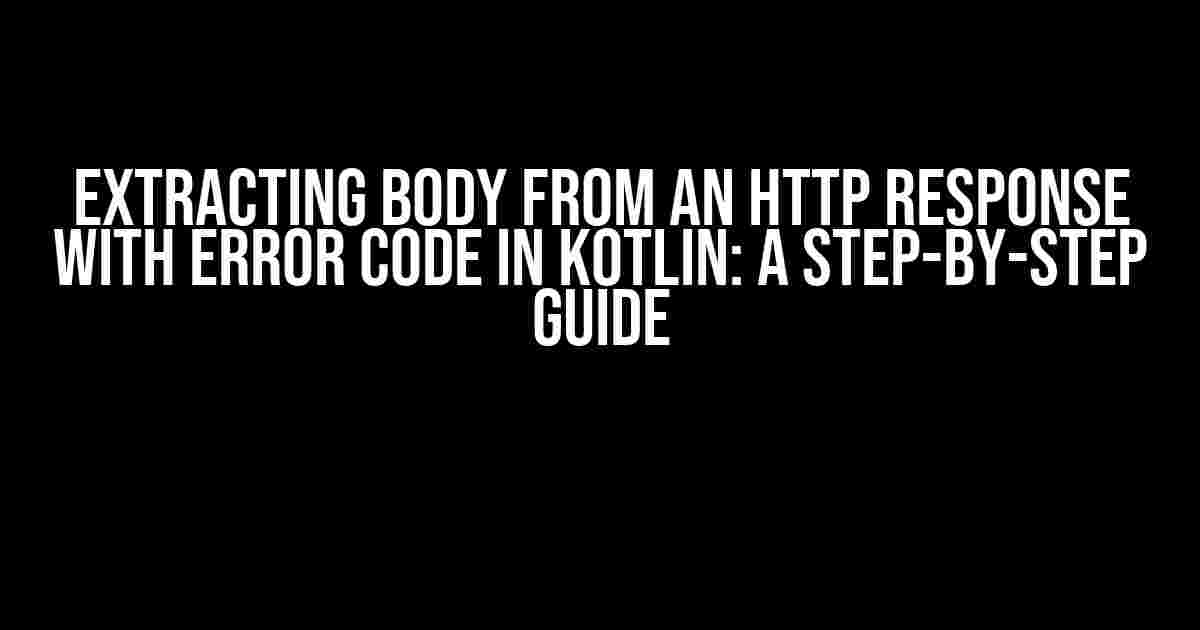When working with HTTP requests in Kotlin, it’s not uncommon to encounter errors. Sometimes, these errors come with valuable information hidden within the response body. But, how do you extract this information when all you have is an error code? In this article, we’ll delve into the world of HTTP responses and explore ways to extract the body from an HTTP response with an error code in Kotlin.
- Understanding HTTP Responses and Error Codes
- The Problem: Extracting the Body from an HTTP Response with an Error Code
- The Solution: Extracting the Body using OkHttp’s ResponseBody
- Alternative Solutions: Using Retrofit’s ResponseBody
- Common Use Cases for Extracting the Body from an HTTP Response with an Error Code
- Best Practices for Working with HTTP Responses in Kotlin
- Conclusion
Understanding HTTP Responses and Error Codes
Before we dive into the solution, let’s take a step back and understand the basics of HTTP responses and error codes.
An HTTP response consists of three main components:
- Status Line: This line contains the HTTP version, status code, and reason phrase.
- Header Fields: These are key-value pairs that provide additional information about the response.
- Body: This is the actual content of the response.
Error codes, on the other hand, are used to indicate the type of error that occurred. Common error codes include:
- 400 Bad Request: The request was invalid or cannot be processed.
- 401 Unauthorized: Authentication is required or has failed.
- 404 Not Found: The requested resource could not be found.
- 500 Internal Server Error: The server encountered an unexpected error.
The Problem: Extracting the Body from an HTTP Response with an Error Code
When an HTTP request returns an error code, it can be challenging to extract the body of the response. This is because the response body is not always readily available, especially when working with popular HTTP libraries like OkHttp or Retrofit.
In Kotlin, you might encounter an error like this:
val response = httpClient.newCall(request).execute()
if (!response.isSuccessful) {
val errorCode = response.code
val errorMessage = response.message
// How do we extract the body from here?
}
As you can see, we have access to the error code and message, but the body remains elusive.
The Solution: Extracting the Body using OkHttp’s ResponseBody
val response = httpClient.newCall(request).execute()
if (!response.isSuccessful) {
val errorCode = response.code
val errorMessage = response.message
val responseBody = response.body
if (responseBody != null) {
val bodyString = responseBody.string()
// Do something with the body string
}
}
In this example, we use the `body()` method to retrieve the ResponseBody object. We then call the `string()` method to convert the response body into a string.
Note that the `string()` method can be memory-intensive for large responses, so use it wisely.
Alternative Solutions: Using Retrofit’s ResponseBody
If you’re using Retrofit, you can also extract the body from the HTTP response using Retrofit’s ResponseBody. Here’s an example:
interface MyApi {
@GET("my-endpoint")
fun getData(): Call<Response<String>>
}
val retrofit = Retrofit.Builder()
.baseUrl("https://my-api.com/")
.build()
val myApi = retrofit.create(MyApi::class.java)
val call = myApi.getData()
val response = call.execute()
if (!response.isSuccessful) {
val errorCode = response.code
val errorMessage = response.message
val responseBody = response.errorBody
if (responseBody != null) {
val bodyString = responseBody.string()
// Do something with the body string
}
}
In this example, we use Retrofit’s `errorBody()` method to retrieve the ResponseBody object. We then call the `string()` method to convert the response body into a string.
Common Use Cases for Extracting the Body from an HTTP Response with an Error Code
So, why would you want to extract the body from an HTTP response with an error code? Here are some common use cases:
- Error Handling: By extracting the body, you can provide more informative error messages to your users or log more detailed error information.
- Debugging: Extracting the body can help you debug issues more efficiently by providing additional context about the error.
- Custom Error Handling: You might want to implement custom error handling logic based on the error code and body. For example, you could retry the request or fallback to a default value.
Best Practices for Working with HTTP Responses in Kotlin
When working with HTTP responses in Kotlin, keep the following best practices in mind:
- Always check the response status code to determine if the request was successful.
- Use a consistent error handling strategy across your application.
- Log error information, including the error code and body, to help with debugging.
- Consider implementing retries or fallbacks for failed requests.
Conclusion
In this article, we explored the challenges of extracting the body from an HTTP response with an error code in Kotlin. We discussed the importance of understanding HTTP responses and error codes, and then delved into two popular solutions using OkHttp’s ResponseBody and Retrofit’s ResponseBody. Finally, we covered common use cases and best practices for working with HTTP responses in Kotlin.
By following these guidelines, you’ll be well-equipped to handle HTTP responses with error codes and extract valuable information from the response body.
| Error Code | Description |
|---|---|
| 400 | Bad Request |
| 401 | Unauthorized |
| 404 | Not Found |
| 500 | Internal Server Error |
We hope this article has been informative and helpful in your Kotlin development journey. Happy coding!
Frequently Asked Question
Kotlin developers, let’s dive into the world of HTTP responses and error codes! Are you ready to extract the body from an HTTP response with an error code in Kotlin?
Q1: What is the importance of extracting the body from an HTTP response with an error code?
Extracting the body from an HTTP response with an error code is crucial because it provides valuable information about the error, allowing you to debug and troubleshoot issues more efficiently. This information can include error messages, stack traces, or other diagnostic data.
Q2: How do I extract the body from an HTTP response with an error code in Kotlin using the OkHttp library?
You can use the `response.body().string()` method to extract the body from an HTTP response with an error code in Kotlin using OkHttp. This method returns the response body as a string, which you can then parse or process accordingly.
Q3: What if the response body is too large to fit in memory? How can I handle this scenario?
If the response body is too large to fit in memory, you can use a streaming approach to process the response body in chunks. OkHttp provides the `response.body().source()` method, which returns a `ResponseBody` object that you can use to stream the response body.
Q4: How can I handle different types of error responses, such as JSON or XML?
To handle different types of error responses, you can use a combination ofmime type detection and serialization libraries, such as Jackson for JSON or XmlPullParser for XML. This allows you to parse the response body based on the `Content-Type` header and deserialize it into a Kotlin object.
Q5: Are there any best practices for handling error responses and extracting the body in Kotlin?
Yes, some best practices include using a centralized error handling mechanism, logging error responses for debugging purposes, and using a robust serialization library to handle different response formats. Additionally, consider using a try-catch block to handle exceptions that may occur during error response processing.


